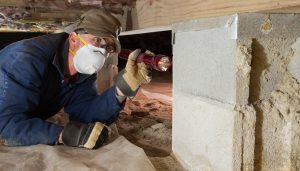If there’s a part of your home that’s all too easy to forget, it’s the crawlspace. Hidden away and seldom entered, crawlspaces are like the unseen underbelly of your home, playing a crucial role in its structural integrity and overall health. Whether you’re a new homeowner, a seasoned property guru, or just curious about home maintenance, understanding the basics of crawlspace safety is essential. Crawlspaces can host a myriad of hazards, from moisture and mold to pests and structural dangers. But, with the right knowledge, protective gear, and best practices, you can navigate this hidden frontier safely and effectively.
Understanding crawlspace dangers is the first step to ensuring both your safety and that of your home. Conditions within a crawlspace can rapidly deteriorate, given their propensity to attract moisture, encourage mold growth, and provide a haven for pests. These issues are not just a threat to the structure of your home but can also pose significant health risks to its inhabitants. Exposure to mold, for instance, can lead to respiratory issues and allergic reactions, while pests like termites and rodents can cause serious damage to the home’s foundation and electrical wiring. Therefore, it’s vital to approach crawlspace inspection and maintenance with caution, armed with knowledge and the right tools.
When it comes to navigating these hidden spaces, wearing the correct protective gear can’t be overstated. Essential items include a flashlight to illuminate your path, goggles to protect your eyes from dust and debris, a respirator to filter out harmful particles, gloves to safeguard your hands, knee pads to cushion your movements, and a durable jumpsuit or coveralls to shield your body. A helmet or padded hat will also protect your head from low-hanging obstacles. This gear not only minimizes the risk of physical injuries but also protects you from harmful substances like mold spores, asbestos fibers, and hantavirus. If properly equipped, you can explore and maintain your crawlspace with confidence.

When performing inspections and maintenance, observing best practices ensures both the safety of the inspector and the integrity of the home. Regularly inspecting your crawlspace allows for the early identification of potential issues, such as water damage, pest infestation, or structural problems. It’s imperative to keep a keen eye out for pooling water, signs of rodents or insects, damaged insulation, and any leaks from pipes. Not only can these signs indicate current issues, but they can also predict future problems if left unaddressed. Remember, what happens in the crawlspace doesn’t stay in the crawlspace; it can affect the entire home.
Despite your best efforts, there may come a time when professional help is required and Yellowhammer Home Inspection Services is there to help. If you encounter dangerous materials like asbestos, serious structural damage, or extensive mold growth, it’s time to call in the experts. Not all crawlspace issues can be safely handled alone, and attempting to do so without proper training and equipment can exacerbate the problem. Professionals can offer solutions such as radon mitigation, structural repairs, pest eradication, and moisture control, ensuring that your home remains safe and sound. Keep in mind, ensuring your crawlspace is routinely checked and maintained by professionals can stave off bigger, costlier issues down the road.
In conclusion, while the crawlspace may be one of the least glamorous parts of home ownership, it’s undeniably important. By understanding the potential dangers, donning appropriate protective gear, adhering to best practices for inspection and maintenance, and knowing when to call in professional help, you can ensure that your home remains a safe and healthy space for all its inhabitants. Stay informed, stay protected, and remember that a little bit of prevention goes a long way when it comes to crawlspace safety.

